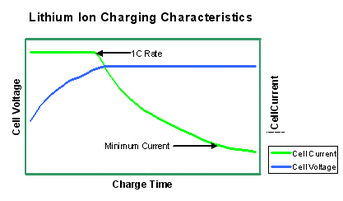Battery Management System (BMS)
 Source - Electropaedia
Source - Electropaedia
The BMS an important piece of software/electronic system, which is used in electric vehicles. This system protects the battery pack which can be damaged by excessively high or low voltages, and in some cases the results can be catastrophic. Battery Management Systems can provide battery charge protections, discharge protections and state-of-charge monitoring.
Battery technologies such as Lithium and NiMh are more sensitive to over-charging and over dis-charging on a cell-by-cell basis. When the cells are used in a series, these battery technologies are generally implemented with a BMS.
Charge Cycle Management
Each type of battery has a different charge profile that needs to be followed.
Lead-Acid battery charging typically have a charge profile of the following:
Bulk charge (I): Initially the battery is charged at a constant (I) rate until the cell voltage reaches a preset value - normally a voltage near to that at which gassing occurs (Usually Lead-Acid batteries release H2 & O2 gases)
Constant Voltage (U): When the preset voltage has been reached, the charger switches into the constant voltage (U) phase and the current drawn by the battery will gradually drop until it reaches another preset level.
Equalize (I): Finally the charger switches again into the constant current mode (I) and the voltage continues to rise up to a new higher preset limit when the charger is switched off. This last phase is used to equalize the charge on the individual cells in a gassing process.
Lithium battery charging has a charge characteristic as shown in the figure on the right
Lithium batteries which are vulnerable to damage if the upper voltage limit is exceeded. Special precautions are needed to ensure the battery is fully charged while at the same time avoiding overcharging. For this reason it is recommended that the charging method switches to constant voltage before the cell voltage reaches its upper limit.
The lithium charge voltage rises rapidly to the cell upper voltage limit, and is subsequently maintained at that level. As the charge approaches completion the current decreases to a trickle charge. Cut off occurs when a predetermined minimum current point, which indicates a full charge, has been reached.
The Battery Management System is a very important component in your electric vehicle and usually interfaces with other on board systems such as engine management, climate controls, communications and safety systems. It acts as the connector between the battery and the vehicle, plays a vital role in improving battery performance and optimizing your EV in a safe and reliable manner.
Important Links & White Papers on BMS
http://www.mpoweruk.com/bms.htm
www.mdpi.com/1996-1073/4/11/1840 (PDF)
Battery technologies such as Lithium and NiMh are more sensitive to over-charging and over dis-charging on a cell-by-cell basis. When the cells are used in a series, these battery technologies are generally implemented with a BMS.
Charge Cycle Management
Each type of battery has a different charge profile that needs to be followed.
Lead-Acid battery charging typically have a charge profile of the following:
Bulk charge (I): Initially the battery is charged at a constant (I) rate until the cell voltage reaches a preset value - normally a voltage near to that at which gassing occurs (Usually Lead-Acid batteries release H2 & O2 gases)
Constant Voltage (U): When the preset voltage has been reached, the charger switches into the constant voltage (U) phase and the current drawn by the battery will gradually drop until it reaches another preset level.
Equalize (I): Finally the charger switches again into the constant current mode (I) and the voltage continues to rise up to a new higher preset limit when the charger is switched off. This last phase is used to equalize the charge on the individual cells in a gassing process.
Lithium battery charging has a charge characteristic as shown in the figure on the right
Lithium batteries which are vulnerable to damage if the upper voltage limit is exceeded. Special precautions are needed to ensure the battery is fully charged while at the same time avoiding overcharging. For this reason it is recommended that the charging method switches to constant voltage before the cell voltage reaches its upper limit.
The lithium charge voltage rises rapidly to the cell upper voltage limit, and is subsequently maintained at that level. As the charge approaches completion the current decreases to a trickle charge. Cut off occurs when a predetermined minimum current point, which indicates a full charge, has been reached.
The Battery Management System is a very important component in your electric vehicle and usually interfaces with other on board systems such as engine management, climate controls, communications and safety systems. It acts as the connector between the battery and the vehicle, plays a vital role in improving battery performance and optimizing your EV in a safe and reliable manner.
Important Links & White Papers on BMS
http://www.mpoweruk.com/bms.htm
www.mdpi.com/1996-1073/4/11/1840 (PDF)
